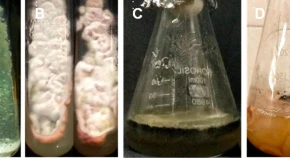Characterization of biocontrol microorganisms from the rhizoplane of Decalepis arayalpathra and screening of secondary metabolites
Research Articles | Published: 07 April, 2020
First Page: 352
Last Page: 359
Views: 3783
Keywords: Rhizoplane, Microflora, Decalepis arayalpathra , Biocontrol, Antimicrobial
Abstract
Microbial communities present in the rhizoplane of plants play an essential role in both plant growth and physiological functioning. These microbes are attracted to the volatile compounds released by plants as a by product of their metabolism. Present investigation was designed to isolate and identify microbes from the rhizoplane regions of the tissue culture raised medicinal plant, Decalepis arayapathra KMA 05 clones. Two fungal species, i.e., Cladosporium sp. F42 (FJ755822) and Epicoccum nigrum (KR094452) were isolated from the rhizoplane. In antagonistic activity assay, E. nigrum was found to inhibit the growth of Cladosporium sp., thus displaying its biocontrol potential. The GC–MS analysis of fungal extracts showed bioactive molecules that can act as anti-microbial, anti-cancerous, and plant growth-promoting molecules. Moreover, exclusive and high concentration of PPDHMP from the E. nigrum supports for its involvement in Cladosporium growth inhibition. Thus the identified microbes can be exploited as biocontrol agents and plant growth-promoting microbes for D. arayalpathra.

References
- Ahmad Z, Shahzad A, Sharma S et al (2018) Ex vitro rescue, physiochemical evaluation, secondary metabolite production and assessment of genetic stability using DNA based molecular markers in regenerated plants of Decalepis salicifolia (Bedd. ex Hook.f.) Venter. Plant Cell Tissue Organ Culture 132:497–510
- Baute MA, Deffieux G, Baute R, Neveu A (1978) New antibiotics from the fungus Epicoccum nigrum. J Antibiotics 31(11):1099–1101
- Brown AE, Finlay R, Ward JS (1987) Antifungal compounds produced by Epicoccum purpurascens against soil-borne plant pathogenic fungi. Soil Biol Biochem 19(6):657–664
- Butt TM, Jackson C, Magan N (eds) (2001) Fungi as biocontrol agents: progress problems and potential. Centre for Agriculture and Biosciences International, Wallingford, p 416
- Gamalero E, Glick BR (2015) Bacterial modulation of plant ethylene levels. Plant Physiol 169(1):13–22
- Golinska P, Wypij M, Agarkar G, Rathod D, Dahm H, Rai M (2015) Endophytic actinobacteria of medicinal plants: diversity and bioactivity. Antonie Van Leeuwenhoek 108(2):267–289
- Harwoko H and Daletos G et al (2019) Dithiodiketopiperazine derivatives from endophytic fungi Trichoderma harzianum and Epicoccum nigrum. Nat Prod Res 1–9
- Jeyaseelan EC, Tharmila S, Niranjan K (2012) Antagonistic activity of Trichoderma spp. and Bacillus spp. against Pythium aphanidermatum isolated from tomato damping off. Arch Appl Sci Res 4(4):1623–1627
- Mendes R, Garbeva P, Raaijmakers JM (2013) The rhizosphere microbiome: significance of plant beneficial, plant pathogenic, and human pathogenic microorganisms. FEMS Microbio Rev 37(5):634–663
- Moricca S, Ragazzi A, Mitchelson KR, Assante G (2001) Antagonism of the twoneedle pine stem rust fungi Cronartium flaccidum and Peridermium pini by Cladosporium tenuissimum in vitro and in planta. Phytopathology 91:457–468
- Ogorek R, Plaskowska E (2010) Epicoccum nigrum for biocontrol agents in vitro of plant fungal pathogens. Commun Agric Appl Biol Sci 76(4):691–697
- Park MS, Gao C, Stern HA (2011) Estimating binding affinities by docking/scoring methods using variable protonation states. Proteins Struct Funct Genet 79(1):304–314
- Paul D, Park KS (2013) Identification of volatiles produced by Cladosporium cladosporioides CL-1, a fungal biocontrol agent that promotes plant growth. Sensors 13(10):13969–13977
- Pieterse CM, Zamioudis C, Berendsen RL, Weller DM, Van Wees SC, Bakker PA (2014) Induced systemic resistance by beneficial microbes. Ann Rev Phytopathol 52:347–375
- Ravikumar K, Ved DK, Vijaya SR, Udayan PS (2000) 100 red listed medicinal plants of conservation concern in Southern India. Foundation for Revitalisation of Local Health Traditions (FRLHT), Bangalore, pp 261–263
- Shine VJ, Shyamal S, Latha PG, Rajasekharan S (2007) Gastric antisecretory and antiulcer activities of Decalepis arayalpathra. Pharm Biol 45:210–216
- Shweta S, Bindu JH et al (2013) Isolation of endophytic bacteria producing the anti-cancer alkaloid camptothecine from Miquelia dentata Bedd. (Icacinaceae). Phytomedicine 20(10):913–917
- Srivastava S, Laisram N, Ram H, Singh VP (2017) Bio-priming of tissue culture raised Decalepis arayalpathra (J. Joseph & V. Chandras.) Venter, KMA 05 clones with the phyllospheric bacterium, Methylobacterium sp. VP103. Vegetos 30:40–51
- Ueda H, Kurose D, Kugimiya S et al (2018) Disease severity enhancement by an esterase from non-phytopathogenic yeast Pseudozyma antarctica and its potential as adjuvant for biocontrol agents. Sci Rep 8(1):16455
- Vandenkoornhuyse P, Quaiser A, Duhamel M, Le Van A, Dufresne A (2015) The importance of the microbiome of the plant holobiont. New Phytol 206(4):1196–1206
- Vigneshwari A, Rakk D, Németh A et al (2019) Host metabolite producing endophytic fungi isolated from Hypericum perforatum. PLoS ONE 14(5):e0217060
- Vishwakarma K, Sharma S, Kumar V, Upadhyay N, Kumar N, Mishra R, Tripathi DK (2017) Current scenario of root exudate-mediated plant-microbe interaction and promotion of plant growth. In: Probiotics in agroecosystem. Springer, Singapore, pp 349–369
- Yadav RKP, Karamanoli K, Vokou D (2010) Estimating bacterial population on the phyllosphere by serial and leaf imprint methods. Ecol Soc 17(4):47–52
- Yim W, Woo S, Kim K, Sa T (2012) Regulation of ethylene emission in tomato (Lycopersicon esculentum Mill.) and red pepper (Capsicum annuum L.) inoculated with ACC deaminase producing Methylobacterium spp. Korean J Soil Sci Fertil 45(1):37–42
- Zeriouh H, de Vicente A, Perez-García A, Romero D (2014) Surfactin triggers biofilm formation of Bacillus subtilis in melon phylloplane and contributes to the biocontrol activity. Environ Microbiol 16(7):2196–2211
- Zhang B, Bai Z et al (2010) Microbial diversity within the phyllosphere of different vegetable species. Curr Res Technol Educ Top Appl Microbiol Microb Biotechnol 16(2):1067–1077
Author Information
Department of Botany, Faculty of Science, University Enclave, New Delhi, India